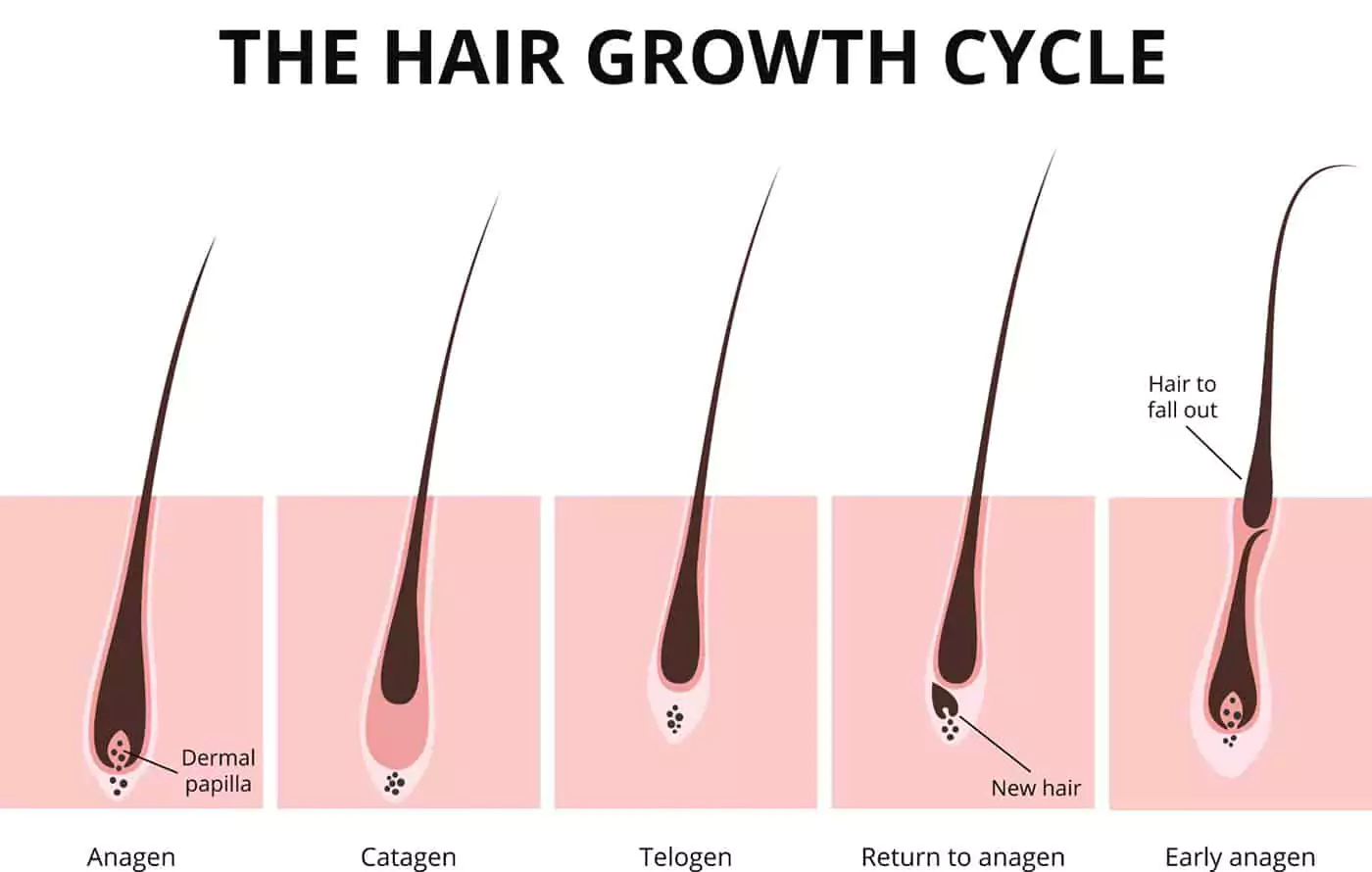Hey there, hair enthusiasts! Ever wondered what’s going on beneath the surface of your scalp? Hair growth isn’t a continuous, magical process; it follows a fascinating cycle with distinct phases. Understanding this cycle can be incredibly helpful, especially if you’re looking to grow your hair longer or if you’re experiencing hair loss. In this comprehensive guide, we’ll unlock the secrets of your hair’s incredible journey, exploring the science behind it and revealing tips for healthier hair growth.
Hair Growth Cycle Explained
Hair growth follows a fascinating cycle with several distinct phases. Understanding these phases can be super helpful, especially if you’re trying to grow your hair longer or figure out why you might be experiencing hair loss. Let’s break it down:
1. Anagen: The Growing Phase
This is the active growth phase where your hair follicles are working tirelessly, pushing out new cells and growing longer. This phase can last anywhere from two to seven years, which explains why some people can grow their hair super long while others struggle to get past a certain length. The length your hair reaches in this phase is pretty much its maximum potential, heavily influenced by genetics!
2. Catagen: The Transitional Phase
After all that hard work growing, your hair follicles need a short break. That’s where the catagen phase comes in, lasting about two to three weeks. It’s like a “time out” for your hair follicles as they shrink a bit and detach from the blood supply, meaning your hair stops growing. Don’t worry, though, the hair is still anchored in there; it’s just getting ready for the next phase.
3. Telogen: The Resting Phase
This is the “chilling out” phase for your hair follicles. They essentially go dormant for around three months. Your hair shaft remains in place, but no new growth is happening. Eventually, the follicle will reactivate, and the whole cycle starts again, sometimes pushing out the old hair to make way for new growth. This is totally normal and why we lose a certain amount of hair every day.
4. Exogen: The Shedding Phase
The exogen phase is the final stage of the hair growth cycle. During this phase, the old hair shaft, which has been resting in the telogen phase, is finally released and falls out. This is a natural process, and it’s why we lose a certain amount of hair every day. Once the old hair is gone, the follicle is ready to jump back to the anagen phase, and the whole cycle begins again.
Factors That Influence Your Hair Growth Cycle
It’s not just about the phases themselves; several things can impact how your hair grows. Here are a few key players:
- Genetics: Your genes play a significant role in determining your hair type, color, and how fast (and long) it grows. For example, people with certain genetic backgrounds might naturally have longer anagen phases, leading to longer hair growth.
- Hormones: Those chemical messengers in your body can influence your hair growth cycle, too. Hormonal changes during puberty, pregnancy, or menopause can lead to changes in hair growth. For example, some women experience thicker hair during pregnancy due to hormonal shifts.
- Diet: Eating a balanced diet with plenty of protein, iron, and other essential nutrients provides the building blocks for healthy hair growth. For example, protein is crucial as hair shafts are primarily composed of a protein called keratin.
- Stress: Chronic stress can impact your body in countless ways, including disrupting your hair growth cycle and potentially contributing to hair loss. It’s thought that stress hormones can interfere with the normal functioning of hair follicles.
Understanding the Bigger Picture
Knowing about the hair growth cycle isn’t just interesting trivia; it can actually be quite useful. For example:
- Hair Loss: If you’re experiencing excessive hair loss, understanding the growth cycle can help you and your doctor determine if it’s a temporary issue or a sign of an underlying condition.
- Hair Treatments: Knowing which phase your hair is in can help determine the effectiveness of certain treatments. For example, treatments targeting hair growth are most effective during the anagen phase.
- Styling Practices: Being aware of the hair growth cycle can encourage you to adopt healthier hair care practices, like avoiding tight hairstyles that can cause breakage and traction alopecia.
While we have a pretty good grasp of the hair growth cycle, there’s always more to learn. Researchers are continually investigating how factors like aging, medications, and even environmental factors impact hair growth. So, stay curious, keep learning, and treat your hair with kindness!
What are the 4 stages of the hair growth cycle?
Let’s delve deeper into the four distinct stages of the hair growth cycle:
1. Anagen Phase: Time to Shine!
This is the active growth phase where the hair follicle is like a factory working overtime to pump out new hair cells. This phase can last anywhere from a couple of years to even longer, like six years for some lucky ducks. This is why some people can grow their hair super long, while others might struggle to get past a certain length. It’s all about how long your anagen phase lasts!
2. Catagen Phase: Slowing Down
The catagen phase is a much shorter phase, only about two to three weeks, where things start to wind down. The hair growth slows down like a car running out of gas, and the follicle itself begins to shrink a bit. The hair shaft, no longer actively growing, starts moving up towards the scalp, getting ready for its grand exit.
3. Telogen Phase: Taking a Breather
The telogen phase is essentially the hair follicle’s vacation time. It can last for a few months (usually around three to four), and during this time, the follicle is basically dormant. The old hair shaft is just chilling, still attached to the follicle, but not really doing much of anything. Meanwhile, underneath the surface, a brand new hair is starting to form, getting ready to take its place.
4. Exogen Phase: Out with the Old!
This is the part of the cycle we probably notice the most – the shedding phase. As the new hair grows, it slowly pushes the old hair shaft out of the follicle, and poof – time to say goodbye! This is why we lose a certain amount of hair every day (don’t worry, it’s totally normal!). Once the old hair is gone, the follicle is ready to jump back to the anagen phase and start the cycle all over again.
Things to keep in mind:
- Just like everything in the human body, hair growth is a cycle, and understanding these stages can help you better understand your own hair.
- The length of each phase can vary from person to person and can also be influenced by factors like age, genetics, nutrition, and overall health.
- If you’re concerned about hair loss or changes in your hair growth cycle, it’s always a good idea to chat with a dermatologist or a healthcare professional. They can give you personalized advice and help you figure out what’s going on.
Keep Exploring!
Scientists are constantly learning more about the hair growth cycle, so what we know today might change tomorrow! Isn’t that cool? If you’re curious to learn more, there are tons of resources available online and in libraries. Happy researching!
How long does a hair cycle last?
Each hair on your head has its own little timer, and it goes through a cycle that can last for years before it even thinks about falling out. Think of it like this: the hair growth journey is like a road trip with a few pit stops along the way.
First Stop: The Anagen Phase – The Growth Spurt!
This is where all the action happens! The anagen phase is like the hair’s growth spurt. It can last anywhere from 2 to 8 years, and during this time, the hair follicle is like a little factory, pumping out new hair cells and pushing that hair shaft longer and longer. The length of this phase actually determines how long your hair can grow. So, if you’ve ever wondered why some people can grow their hair super long and others struggle, it could be because their anagen phase is naturally shorter.
Second Stop: The Catagen Phase – Time to Chill!
After all that growing, the hair needs a breather. The catagen phase is like a short transition period. It only lasts a couple of weeks. The hair follicle starts to shrink a bit, and the hair shaft detaches from the root, kind of like getting ready to move out of its comfy home.
Third Stop: The Telogen Phase – Taking a Long Nap.
Now we’re talking about some serious relaxation. The telogen phase is the resting phase. This can last for a few months, and during this time, the hair shaft just hangs out in the follicle, taking it easy. No more growth here! It’s just chilling, waiting for what’s next.
Final Stop: The Exogen Phase – Making Way for New Beginnings!
All good things must come to an end, right? The exogen phase is when the hair finally says goodbye and sheds. But don’t worry, this is totally normal! It’s just making room for a new hair to start its own growth journey.
So, to sum it all up: the entire hair growth cycle can last anywhere from 2 to 8 years or even longer. That’s a pretty long time! And keep in mind that each hair is on its own individual cycle, so you’re not going to suddenly lose all your hair at once (unless something else is going on, of course).
Scientists are still researching exactly what influences these cycles, but things like age, genetics, hormones, and overall health can all play a role. Pretty fascinating, right?
What is the 7 Year Hair Growth Cycle?
You might have heard this cycle lasts around seven years. While that’s a handy number to remember, it’s more of an average. Some folks’ hair might zoom through the cycle a bit faster, while others might have hair that takes its sweet time. Think of it like a rollercoaster: some have wild, short rides, and some are longer, more leisurely journeys.
Let’s break down this cycle into its main parts:
- Anagen (Growth Phase): This is where the magic happens! Deep down in your scalp, tiny factories called hair follicles are hard at work, pushing out new hair cells. This phase can last anywhere from two to seven years, and it’s the main reason why some people can grow super long hair while others struggle to get past a certain length. It’s all about how long your hair stays in this growth zone.
- Catagen (Transition Phase): Like a well-deserved break, the hair follicle takes a little breather in this phase. The hair shaft starts to detach from the follicle’s blood supply, kind of like a ship slowly untying from the dock. This phase is pretty short, usually only lasting a couple of weeks.
- Telogen (Resting Phase): Time for a nap! The hair follicle chills out, and the old hair just hangs out, still visible but not really growing. This stage can last for a few months.
- Exogen (Shedding Phase): All good things must come to an end, and that includes your hair’s time on your head. In this phase, the old hair finally says goodbye and sheds, making way for a new hair to take its place. You might notice more hairs on your brush or pillow during this stage, but don’t panic – it’s totally normal!
Here’s the kicker: each hair follicle on your head is on its own unique schedule. That’s why you don’t just wake up one day with all your hair gone (phew!). Instead, you’re constantly losing and growing hair, keeping things nice and balanced.
But here’s where things get really interesting. This whole cycle – the speed, the duration of each phase – it’s all influenced by a bunch of different things. Your genes play a big role. Ever notice how some families have consistently thick or thin hair? That’s genetics at work!
Hormones also love to get involved, which is why you might notice changes in your hair during pregnancy or menopause. And don’t forget about good ol’ diet and stress levels; they can definitely impact your hair’s growth cycle too.
Scientists are still unraveling all the mysteries of the hair growth cycle, and new discoveries are being made all the time. So while that “7-year cycle” is a good starting point, remember that your hair is as unique as you are!
How long is the cell cycle for hair?
The duration of the hair growth cycle, essentially the lifespan of a hair follicle, can vary greatly depending on a number of factors, including genetics, age, overall health, and environmental influences. It’s a complex process influenced by both internal and external factors.
The Four Stages:
The hair growth cycle is divided into four distinct stages:
- Anagen (Growing Phase): This phase is the most significant, lasting anywhere from 3 to 7 years on the scalp. During this time, hair follicles actively produce new hair cells, and the hair grows at an average rate of half an inch per month.
- Catagen (Transition Phase): This brief transitional phase lasts about 2-3 weeks. Hair growth slows down, and the hair follicle begins to shrink.
- Telogen (Resting Phase): This phase lasts for about 3 months. The hair follicle is dormant and does not produce new hair. However, the hair shaft remains attached to the scalp.
- Exogen (Shedding Phase): The hair is finally shed from the scalp during this phase, which can last a few weeks.
Factors Influencing the Hair Cell Cycle:
- Genetics: Plays a significant role in determining the length of each stage of the hair growth cycle.
- Age: As we age, the hair growth cycle tends to shorten, leading to slower hair growth and thinner hair.
- Hormones: Hormonal changes, such as those that occur during puberty, pregnancy, and menopause, can impact the hair growth cycle.
- Nutrition: A balanced diet rich in protein, vitamins, and minerals is essential for healthy hair growth.
- Stress: Chronic stress can disrupt the hair growth cycle and contribute to hair loss.
While the average hair growth cycle lasts around 5-7 years, individual variations are common. Factors like ethnicity and even the location of the hair on the body can influence the cycle’s length.
How to tell if hair is in the anagen phase?
Since anagen is all about growth, the hair itself usually looks pretty healthy. It tends to have a good amount of shine because the natural oils from your scalp can easily travel down the hair shaft. You’re less likely to see split ends or breakage at this stage because the hair is still relatively new and hasn’t had as much time to get damaged.
How to Accelerate Hair Growth?
We’ve already covered the basics, but let’s dive a little deeper into how to get those luscious locks growing faster.
Riding the Growth Cycle Wave
Think of your hair growth like the seasons – there’s a natural cycle it goes through. You’ve got the anagen phase, where your hair is all about growth and going strong for a good 2 to 6 years. Then comes catagen, a short transitional phase (just 2-3 weeks) where things slow down, and the hair follicle shrinks a bit. Finally, there’s telogen, the resting phase (3-4 months), where the follicle chills out, and the hair shaft decides it’s time to move on (aka, shedding).
Knowing this cycle is like having a secret weapon. It helps you understand what’s normal, spot potential problems, and figure out the best ways to care for your hair.
Feeding Your Follicles: The Food-Hair Connection
You know how eating healthy makes you feel good on the inside? Well, it shows on the outside, too, especially when it comes to your hair. Just like your body needs the right nutrients to thrive, so does your hair!
A balanced diet packed with vitamins like A, B7 (biotin), B12, and minerals like zinc and iron is like superfood for your hair follicles. And don’t forget protein – it’s the building block of hair! Since hair is primarily made of a protein called keratin, getting enough protein in your diet is like giving your hair the construction materials it needs to grow long and strong.
So, load up on those leafy greens, lean proteins, and colorful fruits and veggies – your hair will thank you for it!
Kicking the Habit for Healthier Hair
Alright, time for a little tough love: smoking is a big no-no for hair growth. Think of it this way – smoking damages those precious hair follicles, the tiny factories responsible for making your hair. And when those factories are out of commission, hair growth takes a hit.
The good news? Quitting smoking can be a game-changer for your hair. It’s like hitting the reset button and giving your body (and your hair) a chance to recover and thrive.
Exploring the Cutting Edge of Hair Growth
Beyond the basics, there are some exciting new approaches to hair growth that are worth exploring:
- Laser Therapy: Imagine giving your scalp a little wake-up call with lasers. That’s what laser therapy does! It uses low-level lasers to stimulate those sleepy hair follicles and encourage them to get back to work producing hair.
- Microneedling: This might sound a little intimidating, but it’s actually quite simple. Microneedling involves using tiny needles to create micro-injuries on the scalp. Don’t worry, it’s not as scary as it sounds! These micro-injuries actually trigger the body’s natural healing process, which in turn can improve blood circulation to the scalp and potentially stimulate hair growth.
- Topical Medications: Sometimes, a little extra help is needed, and that’s where topical medications like minoxidil come in. Minoxidil is a popular over-the-counter treatment that’s been shown to help with hair regrowth. While scientists are still trying to figure out exactly how it works its magic, it’s thought to increase blood flow to the hair follicles and extend the growth phase of the hair cycle.
It’s important to remember that everyone’s hair is different, and what works wonders for one person might not be as effective for another. It’s always a good idea to chat with a dermatologist or trichologist (a hair and scalp specialist) to figure out the best approach for your unique hair type and concerns.
The Hair Growth Journey: It’s a Marathon, Not a Sprint
Accelerating hair growth takes time and patience. It’s about making lifestyle changes, nourishing your body from the inside out, and exploring options that align with your needs and preferences.
Keep in mind that research on hair growth is ongoing, and new discoveries are being made all the time. So stay curious, explore your options, and remember that a holistic approach is key!
What are the four main hair growth patterns?
Scientists believe that hair growth patterns, while broadly categorized into the four stages we’ve discussed, might have subtle variations depending on factors like ethnicity, age, and even the location on the body where the hair is growing. Let’s explore this further:
1. Variations in Anagen Phase Duration
The anagen phase, being the growth phase, is particularly interesting when it comes to variations. Research suggests that individuals of Asian descent tend to have longer anagen phases compared to other ethnicities. This could be one of the reasons why they can often grow their hair to impressive lengths.
2. Age and Hair Growth Patterns
Our age, too, seems to play a role in how our hair grows. As we get older, it’s not just that the hair growth cycle might shorten, but the actual structure of the hair shaft can change. Hair strands tend to become thinner and more fragile with age, which is why many people experience thinner hair as they get older.
3. Body Location Matters
Believe it or not, the hair on our head doesn’t grow at the same rate as the hair on other parts of our body. For example, the hair on our legs and arms typically has a much shorter anagen phase compared to scalp hair. That’s why it doesn’t grow as long and why we don’t need to shave our heads as often as we shave our legs!
What is the 4c Hair Growth Cycle?
4c hair, known for its tight coils and beautiful texture, often experiences shrinkage, making it seem like it grows slower. However, it goes through the same four stages of the hair growth cycle as other hair types:
1. Anagen (Growing Phase) – The Growing Party!
This is where the magic happens! The anagen phase is all about growth, growth, growth! Think of it as your hair throwing a years-long growing party! During this time, your hair follicles are working hard, creating brand new hair shafts that push up and out of your scalp. This phase can last for a couple of years or even longer – it’s different for everyone.
2. Catagen (Transition Phase) – Time to Chill Out
All parties have to end sometime, right? That’s what the catagen phase is all about – it’s like your hair taking a little break. In this phase, which lasts for a few weeks, the hair follicle starts to shrink a bit, and it takes a step back from all that growing. It’s like it’s getting ready to go dormant for a bit.
3. Telogen (Resting Phase) – A Well-Deserved Nap
Time for a nap! The telogen phase is like a peaceful naptime for your hair. The hair shaft just hangs out in the follicle, relaxing for a few months. It’s not growing, but it’s not falling out either. It’s just chilling, waiting for the next exciting phase.
4. Exogen (Shedding Phase) – Out with the Old!
Don’t be alarmed by the word “shedding”! This is totally normal. The exogen phase is when those old, resting hairs finally decide to let go, making way for new growth. It’s like a natural shedding process. And guess what? As soon as an old hair falls out, a brand new hair is ready to pop up in its place, starting the whole cycle all over again!
Why Does This Matter?
Understanding these stages helps you figure out how to care for your 4c hair better. It helps you understand things like why you might be shedding more at certain times, or why your hair seems to grow faster or slower during certain periods. Pretty cool, right?
At what age does hair stop growing on your head?
So, you’ve been noticing your hair isn’t quite what it used to be? Maybe it doesn’t grow as fast, or perhaps it seems a little thinner these days. It’s a common question – at what age does hair stop growing on your head?
The truth is, it’s a bit like asking how long a piece of string is. There’s no magic number, and everyone’s different!
Think of it like this: your hair follicles (those tiny pockets in your scalp where hair grows) are always on a journey, cycling through different phases. First, there’s the anagen phase, which is like the “growth spurt” stage. This can last anywhere from a couple of years to almost a decade, and that’s when your hair really struts its stuff, getting longer and stronger.
Then comes the catagen phase, a sort of “time out” period of a few weeks where the follicle takes a breather and the hair chills out. Finally, there’s the telogen phase, a resting phase lasting a few months. The old hair hangs around until it eventually decides to peace out (hello, shower drain!), and then the whole cycle starts again.
Now, here’s the thing: as you get older, these cycles can get a little, shall we say, leisurely. That active growth phase might not be as long as it used to be, which can mean your hair isn’t quite as thick or long. This is totally normal, though some people might start noticing these changes in their 30s or 40s, while others might not see a difference until later on.
While there’s no set age when your hair throws in the towel on growing, it’s pretty common for things to slow down a bit after age 50. But remember, everyone’s different! Genes play a big role, and things like stress, diet, and overall health can also affect your hair.
If you’re really concerned about hair loss, it’s always a good idea to chat with your doctor. They can help rule out any underlying medical conditions and might even have some suggestions for slowing things down or giving your hair a little boost. After all, a healthy head of hair is something to be proud of, no matter your age!
How to Tell if Hair is Growing Back?
We’ve all been there – staring in the mirror, wondering if our hair is actually growing back. Maybe you’ve recently noticed some thinning or had a haircut you weren’t thrilled about. Whatever the reason, it’s natural to want to see those strands returning to their former glory. Don’t worry, there’s hope! Hair loss is often temporary, and understanding how to spot the signs of regrowth can give you peace of mind.
Here’s the thing: hair growth isn’t a straightforward process. Knowing what to look for during these phases is key to determining if your hair is truly bouncing back.
Let’s break it down:
1. The Amazing Hair Growth Cycle
- Growth Phase (Anagen): This is where the magic happens. Hair follicles are busy producing new hair strands, and this is where most of your hair spends its time (about 90%!).
- Transitional Phase (Catagen): Time for a little break! In this phase, hair growth slows down, and the follicle starts to shrink.
- Resting Phase (Telogen): Don’t worry, this doesn’t mean your hair stops growing altogether. During this phase, the hair shaft chills out in the follicle.
- Shedding Phase (Exogen): Out with the old! This is the phase where old hair strands naturally fall out to make way for new ones.
2. Spotting the Comeback: Signs of Hair Regrowth
So, how can you tell if your hair is actually growing back? Look out for these telltale signs:
- Stubble is Your Friend: Remember that slightly prickly feeling after shaving? That’s stubble, and it’s a great indicator of new hair growth. If you see tiny hairs popping up around your scalp, it means your hair follicles are waking up and getting back to business.
- Longer Strands: Hello, Progress! As those tiny stubble hairs continue to grow, you’ll start to notice longer strands emerging. This is a clear sign that the growth phase is in full swing and your hair is on its way back to its former glory.
3. The Power of Understanding
Knowing how your hair grows and the different stages it goes through is empowering. It can help you make informed decisions about your hair care routine and manage your expectations. For example, if you understand that shedding is a natural part of the cycle, you might not panic when you see a few strands in your brush.
What the Experts Say:
Research suggests that various factors can influence hair growth, including genetics, hormones, nutrition, and even stress levels. While there’s no one-size-fits-all answer to hair regrowth, understanding the science behind it can help you take a proactive approach to hair health.
The Bottom Line:
If you’re concerned about hair loss, remember that you’re not alone. Millions of people experience it at some point in their lives. Pay close attention to your scalp, look for those signs of regrowth, and be patient. With time and proper care, your hair will likely make a comeback.
And remember, if you have any persistent concerns about hair loss, it’s always a good idea to consult with a healthcare professional or a dermatologist.
Did you know that hair grows faster in the summer? You can learn more and be amazed with 10 amazing facts about hair! Are you aware that in some cultures, your hairstyle is more than just a style? Dive deep into the cultural significance of hairstyles to find out more.
- Star Ring Trends: Etsy vs Amazon - March 28, 2025
- Boost Pollinator Habitats: Baby Blue Eyes Sustainable Farming Guide - March 28, 2025
- Protect Big Black Bears: Effective Conservation Strategies - March 28, 2025
















